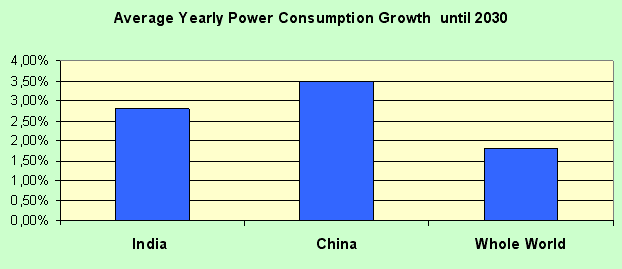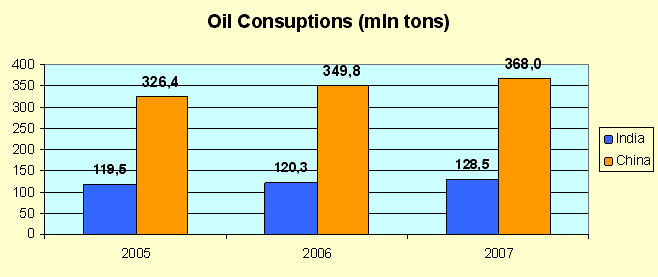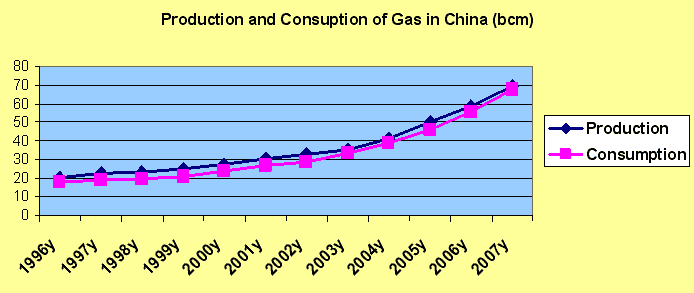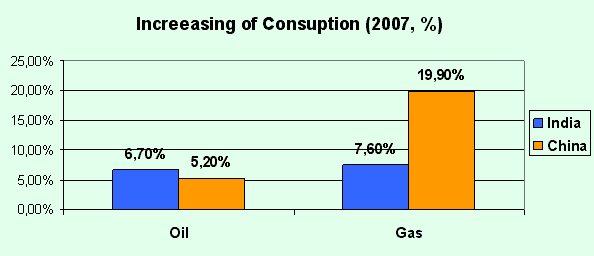 |
 |
 |
 |
 |
 |
 |
 |

Main page > Conferences > Russia and India&China Prospects of Energy Cooperation
Russia and India&China Prospects of Energy Cooperation
Key topics of Konstantin Simonov's speech at The International conference “Asia-Pacific Security Challenges: Implications for Europe and the Atlantic Alliance”
Prague, Czech Republic, September 9, 2008.
(Read this speech's presentation in PDF  150 KB)
150 KB)
China and India: Much in Common
- Traditional stake on coal: 56% in energy generation of India, 65% in energy generation in China
- Lack of Oil and Gas Reserves
- Forecast of economic growth is 8-12%
- Diagnostic: hydrocarbon starvation

Source: EIA
First Problem will be Oil
- Serious gap between oil production and consumption: 90 mln tons in India and 180 mln tons in China

Source: BP
Second Problem will be Gas

Source: BP
- Gas production in India in 2006 was 30,4 bcm, consumption - 36,6 bcm
- The serious increasing of consumption: the production of gas will be behind consumption very soon
- International Energy Agency: China import of gas in 2020 will be 80-160 bcm
- Forecast of gas consumption in India : 2010 - 75,6 bcm, 2012 - 114 bcm, 2030 - 243 bcm. Forecast of production in 2030 is less then 40 bcm

Source: BP
Crusade for Oil and Gas
- At the end of 2006 India invested more them $5,5 bln to foreign upstream ($2,8 bln in Russia). Projects in 14 countries
- But energy expansion has serious limitation
- Europe and United States will be competitors of IC in Arabian Gulf, Central Asia and Africa
China and India in Energy Trap
| 10 Main Countries on Proved Reserves of Oil (2007) | 10 Main Countries on Proved Reserves of Gas (2007) | ||
|---|---|---|---|
| Saudi Arabia | 21,3% | Russia | 25,2% |
| Iran | 11,2% | Iran | 15,7% |
| Iraq | 9,3% | Quatar | 14,4% |
| Kuwait | 8,2% | Saudi Arabia | 4,0% |
| UAE | 7,9% | USA | 3,4% |
| Venezuela | 7,0% | UAE | 3,4% |
| Russia | 6,4% | Nigeria | 3,0% |
| Libya | 3,3% | Venezuela | 2,9% |
| Kazakhstan | 3,2% | Algeria | 2,5% |
| Nigeria | 2,9% | Iraq | 1,8% |
- Oil: more diffused raw material but the problem of transportation (Strait of Hormuz)
- Gas: three countries control 55% of proved reserves
Diversification of Ånergy Supply – Impermissible Profusion
- Sutuation with gas is the most dramatic
- LNG: the beginning of supply from Australia, Algeria, Nigeria, Oman, Malaysia and Indonesia. But the stake on LNG can be problematic. This market is very competitive
- Australia, Malaysia, Indonesia, Burma – local solutions (no serious reserves, no possibilities of significant increasing of production)
- Central Asia: “word of honour reserves”
- Turkmenistan: Production of gas in 2007 was 67,4 bcm ( 2,7%)
- “Word of honour”: 250 bcm in 2015 ( 370%!!!)
Two Gas Alternative
- Real alternative: Russia or Iran
- Iran: two Problems. Political Future and Transportation Routes. Pipeline form Iran to India through Pakistan. More than 2000 km of political instability
- Russia: the problem of Choice between European and Asian Markets
- January-August, 2008: oil production 0,6% gas production 3,1%
- Special thanks from China and India to the theorists of “energy weapon” and “diversification of energy supply to Europe”
Thank you!
Special report:
Nord Stream 2 and Ukraine: Costs Should Decide
Shale Revolution: Myths and Realities
Liquefied Natural Gas Outlook: Expectations and Reality
Analytical series “The Fuel and Energy Complex of Russia”:
Oil and Gas Sector Regulation and Interim Results in 2024. Outlook for 2025
Northern Logistics Route: Should One Expect a Breakthrough?
Current Status of Russian Oil Exports
Green and Climate Agenda: Reset Attempt
Government 2024: New Configuration of Regulators
Lithium: New Energy Eldorado?
West’s Latest Sanctions Decisions, Their Effect on Russian Oil and Gas Industry
State regulation of the oil and gas sector in 2023, 2024 outlook
All reports for: 2015 , 14 , 13 , 12 , 11 , 10 , 09 , 08 , 07

About us | Products | Comments | Services | Books | Conferences | Our clients | Price list | Site map | Contacts
Consulting services, political risks assessment on the Fuel & Energy Industry, concern of pilitical and economic Elite within the Oil-and-Gas sector.National Energy Security Fund © 2007


 There has been much discussion about how Russia – Europe’s biggest gas supplier – can continue to supply gas to Europe over the coming decades in the most secure and cost efficient way. Gazprom and its European partners have decided that building two additional pipelines through the Baltic Sea (Nord Stream 2) is the best commercial solution to secure future gas supplies for the EU, where gas production continues to decline and demand is expected to grow.
There has been much discussion about how Russia – Europe’s biggest gas supplier – can continue to supply gas to Europe over the coming decades in the most secure and cost efficient way. Gazprom and its European partners have decided that building two additional pipelines through the Baltic Sea (Nord Stream 2) is the best commercial solution to secure future gas supplies for the EU, where gas production continues to decline and demand is expected to grow. The boom in shale gas production in the US and its wide-ranging influence on markets rocked the gas world. Liquefied gas deliveries were redirected, altering the already fragile balance of demand and supply in traditional markets for pipeline gas in Europe.
The boom in shale gas production in the US and its wide-ranging influence on markets rocked the gas world. Liquefied gas deliveries were redirected, altering the already fragile balance of demand and supply in traditional markets for pipeline gas in Europe. World market has shown interest to liquefied gas. Russia has so far been aside of it. However, producers have announced several large LNG projects. The new study will help investigate this delicate subject and understand what is in store for LNG production and export in the nearest years.
World market has shown interest to liquefied gas. Russia has so far been aside of it. However, producers have announced several large LNG projects. The new study will help investigate this delicate subject and understand what is in store for LNG production and export in the nearest years. A new government was formed in Russia in spring 2024. Sergey Tsivilyov became Energy Minister. The first six months of the new government’s regulation of the fuel and energy sector are already past, which enables drawing the first analytical conclusions. Therefore, interim production results for 2024 have a special place in this research. We analyse the past year in two papers at once, as has become a tradition already. The gas industry is considered in a separate report. Meanwhile, we focus on oil here. The report’s special value lies in the data of our own oil export estimation model.
A new government was formed in Russia in spring 2024. Sergey Tsivilyov became Energy Minister. The first six months of the new government’s regulation of the fuel and energy sector are already past, which enables drawing the first analytical conclusions. Therefore, interim production results for 2024 have a special place in this research. We analyse the past year in two papers at once, as has become a tradition already. The gas industry is considered in a separate report. Meanwhile, we focus on oil here. The report’s special value lies in the data of our own oil export estimation model. The Northern Sea Route and the Arctic in general were made a state priority even before the conflict in Ukraine. The key question is: can nice talk about the NSR as a profitable and strategic route and about Russia’s return to the Arctic be converted into actual breakthroughs making it possible to carry out at least the executive’s own plans? The strategic content concerning the NSR is relatively new, but many problems are old.
The Northern Sea Route and the Arctic in general were made a state priority even before the conflict in Ukraine. The key question is: can nice talk about the NSR as a profitable and strategic route and about Russia’s return to the Arctic be converted into actual breakthroughs making it possible to carry out at least the executive’s own plans? The strategic content concerning the NSR is relatively new, but many problems are old. Getting over the 2022-2024 sanctions is the most important test for the Russian oil industry. After the US, United Kingdom, EU, and G7 introduced a ban on buying Russian oil and petroleum products (with some exceptions) and the price cap mechanism, Russia managed to find alternative sale options in countries that are now commonly called the “Global South”. However, it is important to consider exports in detail. This is what we do in the new NESF report.
Getting over the 2022-2024 sanctions is the most important test for the Russian oil industry. After the US, United Kingdom, EU, and G7 introduced a ban on buying Russian oil and petroleum products (with some exceptions) and the price cap mechanism, Russia managed to find alternative sale options in countries that are now commonly called the “Global South”. However, it is important to consider exports in detail. This is what we do in the new NESF report. In spite of dramatic worsening of relations with the West, the subject of climate has not vanished from Russian economic plans. Environmental issues have even topped the list of declared problems.
In spite of dramatic worsening of relations with the West, the subject of climate has not vanished from Russian economic plans. Environmental issues have even topped the list of declared problems. While the result of the presidential election in Russia was absolutely predictable, further moves forming new government agencies were more intriguing. Eventually, on the one hand, it would seem that Putin chose to avoid radical decisions on the civilian part of the Cabinet. Prime Minister Mishustin kept his post and almost all deputy prime ministers did. On the other, there are still meaningful changes. First of all, the Ministry of Energy got a new head. This alone deserves special attention.
While the result of the presidential election in Russia was absolutely predictable, further moves forming new government agencies were more intriguing. Eventually, on the one hand, it would seem that Putin chose to avoid radical decisions on the civilian part of the Cabinet. Prime Minister Mishustin kept his post and almost all deputy prime ministers did. On the other, there are still meaningful changes. First of all, the Ministry of Energy got a new head. This alone deserves special attention. The energy transition is, on the one hand, rightly perceived by Russian oil and gas companies as a threat to their business. On the other, one should also look for new opportunities in the new energy industry. One of them is the production of lithium, the most important resource for electric vehicle batteries. The industry is rapidly growing, which opens up new horizons, for conventional fuel and energy companies, among others. Lithium is already beginning to cause increased interest in Russia, which calls for close scrutiny of the topic.
The energy transition is, on the one hand, rightly perceived by Russian oil and gas companies as a threat to their business. On the other, one should also look for new opportunities in the new energy industry. One of them is the production of lithium, the most important resource for electric vehicle batteries. The industry is rapidly growing, which opens up new horizons, for conventional fuel and energy companies, among others. Lithium is already beginning to cause increased interest in Russia, which calls for close scrutiny of the topic. The report presents an analysis of the latest sanctions decisions on the part of the US, EU, and United Kingdom as well as practical measures to implement them.
The report presents an analysis of the latest sanctions decisions on the part of the US, EU, and United Kingdom as well as practical measures to implement them. The year 2023 posed a serious challenge to the Russian oil and gas sector that was subjected to extremely tough sanctions that could have led to collapse in exports of crude oil and petroleum products. The oil industry and corresponding regulatory mechanisms were tested throughout the year. The state, being in dire need of financial resources, had to save the chicken that lays golden eggs. How well is it coping with this task?
The year 2023 posed a serious challenge to the Russian oil and gas sector that was subjected to extremely tough sanctions that could have led to collapse in exports of crude oil and petroleum products. The oil industry and corresponding regulatory mechanisms were tested throughout the year. The state, being in dire need of financial resources, had to save the chicken that lays golden eggs. How well is it coping with this task?